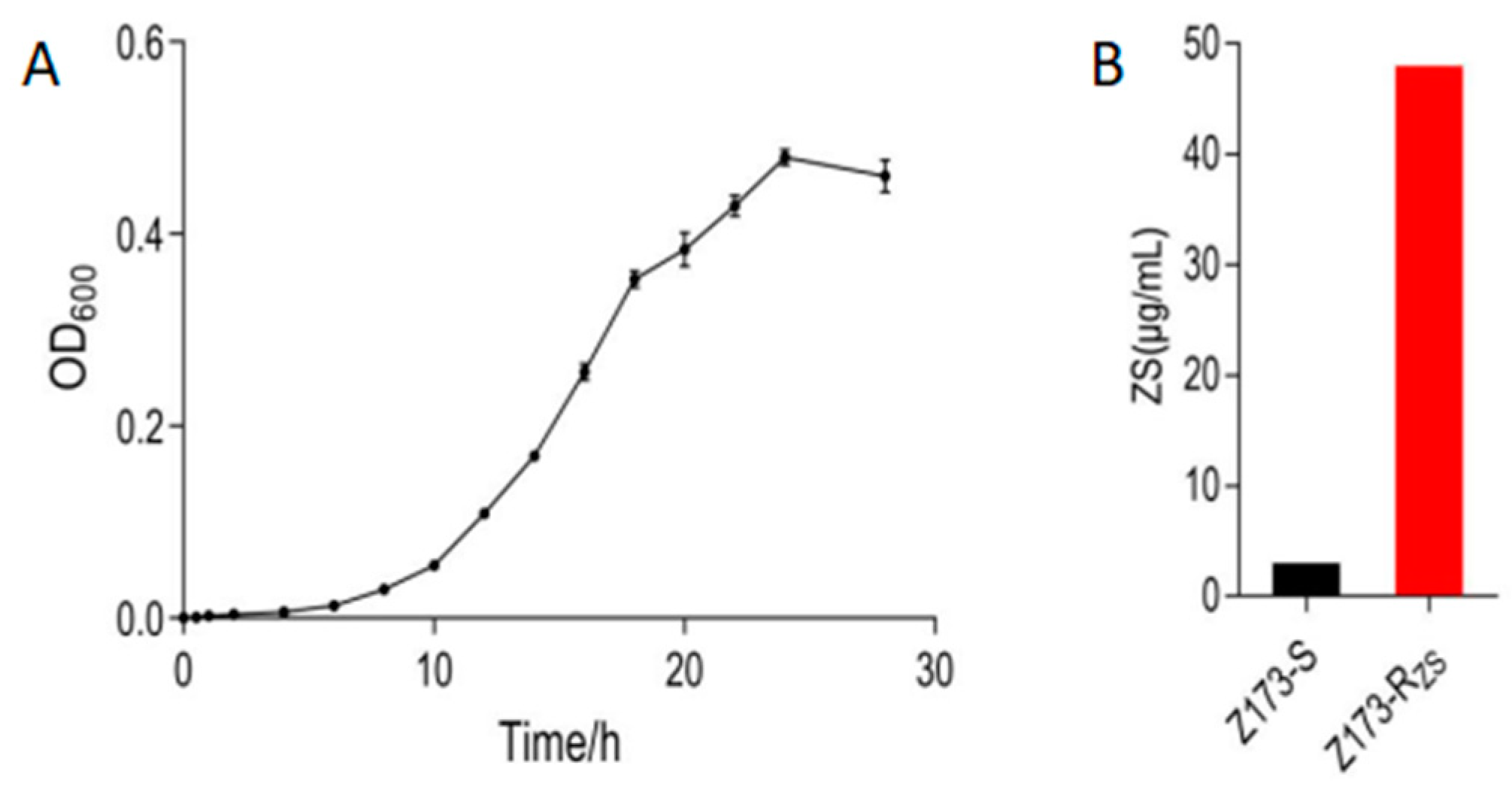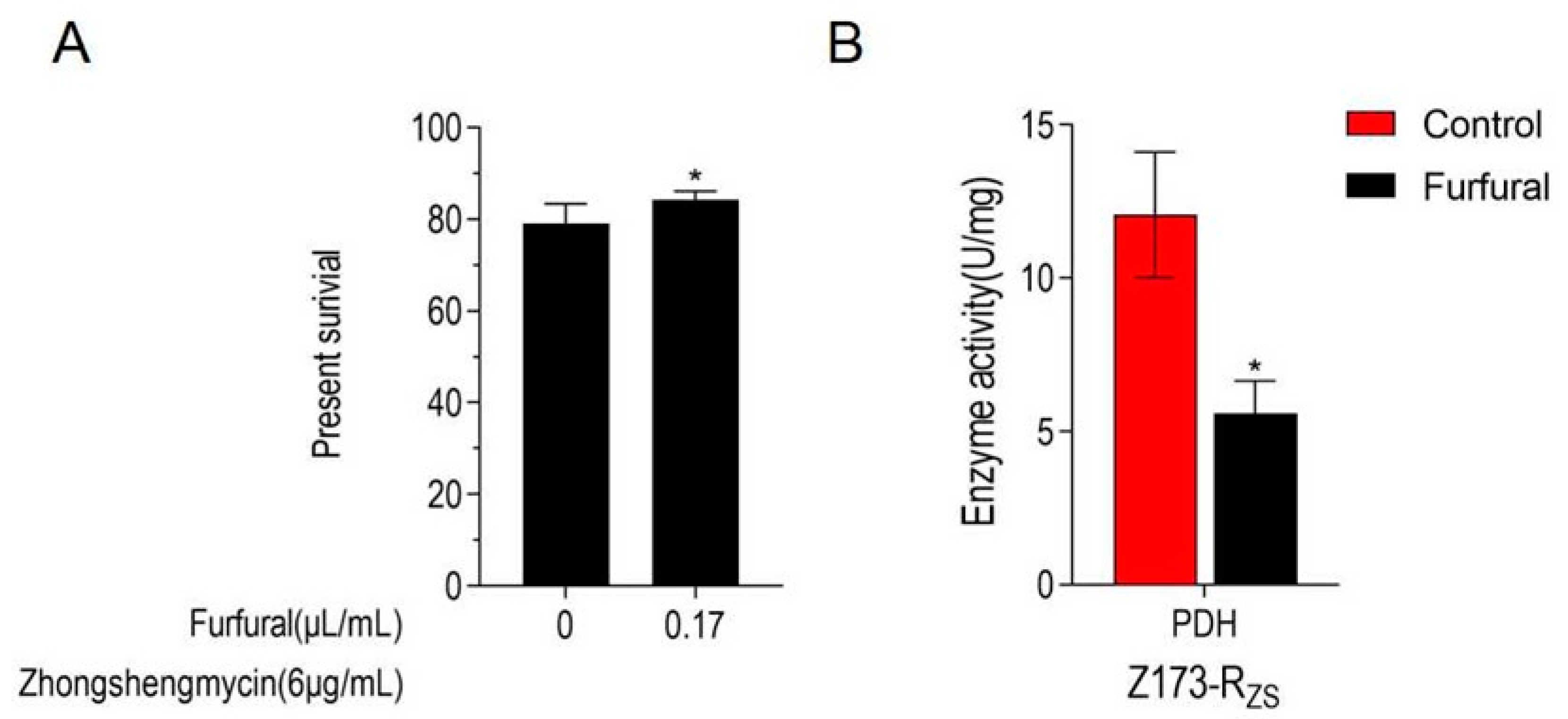Alanine-Dependent TCA Cycle Promotion Restores the Zhongshengmycin-Susceptibility in Xanthomonas oryzae
Abstract
:1. Introduction
2. Results
2.1. Basic Phenotypes of Z173-S and Z173-RZS
2.2. Metabolomic Analysis of Z173-S and Z173-RZS
2.3. Enrichment Pathway Analysis
2.4. The Depressed TCA Cycle Is Associated with Z173-RZS Resistance to ZSM
2.5. Inhibition of the TCA Cycle Promoted the Survival Rate of Z173-RZS under ZSM Stress
2.6. Exogenous Alanine Elevates the Sensitivity of Z173-RZS to ZSM
3. Discussion
4. Materials and Methods
4.1. Bacterial Strains and Growth Conditions
4.2. Measurement of Growth Curve
4.3. Minimum Inhibitory Concentration Detection (MIC)
4.4. Metabolomic Profiling
4.5. GC-MS Detection and Statistical Analysis
4.6. Antimicrobial Bactericidal Assays
4.7. qRT-PCR
4.8. Enzyme Activity Determination
5. Conclusions
Supplementary Materials
Author Contributions
Funding
Data Availability Statement
Acknowledgments
Conflicts of Interest
References
- Oerke, E.C. Crop losses to pests. J. Agric. Sci. 2006, 144, 31–43. [Google Scholar] [CrossRef]
- Streubel, J.; Pesce, C.; Hutin, M.; Koebnik, R.; Boch, J.; Szurek, B. Five phylogenetically close rice SWEET genes confer TAL effector-mediated susceptibility to Xanthomonas oryzae pv. oryzae. New Phytol. 2013, 200, 808–819. [Google Scholar] [CrossRef]
- Nino-Liu, D.O.; Ronald, P.C.; Bogdanove, A.J. Xanthomonas oryzae pathovars: Model pathogens of a model crop. Mol. Plant Pathol. 2006, 7, 303–324. [Google Scholar] [CrossRef]
- McManus, P.S.; Stockwell, V.O.; Sundin, G.W.; Jones, A.L. Antibiotic use in plant agriculture. Annu. Rev. Phytopathol. 2002, 40, 443–465. [Google Scholar] [CrossRef] [PubMed]
- Jiang, X.; Zhu, C.; Ji, J.; Sun, D.; Wei, G.; Tian, Y. Mechanism of zhongshengmycin in control of xanthomonas oryzae pv.oryzae. Chin. J. Biol. Control 2003, 19, 69–72. [Google Scholar]
- Lee, M.Y.; Kim, H.Y.; Lee, S.; Kim, J.G.; Suh, J.W.; Lee, C.H. Metabolomics-Based Chemotaxonomic Classification of Streptomyces spp. and Its Correlation with Antibacterial Activity. J. Microbiol. Biotechnol. 2015, 25, 1265–1274. [Google Scholar] [CrossRef] [PubMed]
- McGhee, G.C.; Sundin, G.W. Evaluation of Kasugamycin for Fire Blight Management, Effect on Nontarget Bacteria, and Assessment of Kasugamycin Resistance Potential in Erwinia amylovora. Phytopathology 2011, 101, 192–204. [Google Scholar] [CrossRef]
- Yao, Y.L.; Pan, Z.C.; Zheng, P.F.; Gao, M.N.; Yang, H.B.; Li, P.M. Advance in Application of Zhongshengmycin Prevention and Treatment of Plant Disease. J. Hengyang Norm. Univ 2019, 40, 93–98. [Google Scholar] [CrossRef]
- Zhao, R.Y.; Li, D.T.; Wang, X.L.; Li, Z.; Yu, X.P.; Shentu, X.P. Synergistic and Additive Interactions of Zhongshengmycin to the Chemical Insecticide Pymetrozine for Controlling Nilaparvata lugens (Hemiptera: Delphacidae). Front. Physiol. 2022, 13, 875610. [Google Scholar] [CrossRef]
- Qiao, T.; Wang, L.; Zhu, T. Screening of bactericides and their control effect against bacterial black spot disease of walnut. Plant Prot. 2020, 46, 258. [Google Scholar]
- Guan, Y.; Shen, P.H.; Lin, M.Y.; Ye, X.Y. Exogenous Alanine Reverses the Bacterial Resistance to Zhongshengmycin with the Promotion of the P Cycle in Xanthomonas oryzae. Antibiotics 2022, 11, 245. [Google Scholar] [CrossRef]
- Ying, X. Occurrence and Mechanisms of Streptomycin and Bismerthiazol Resistance in Xanthohonas Thohonas Oryzae pv. Oryzae in China; Nanjing Agricultural University: Nanjing, China, 2010. [Google Scholar]
- Zhu, X.F.; Zhou, M.G. Detection of the Resistance in Xanthomonas Oryzae pv. Oryzae and X. Oryzae pv. Oryzicola to Two Bactericides and the Assentment of Resistance Risk In Vitro; Nanjing Agricultural University: Nanjing, China, 2010. [Google Scholar]
- Pan, X.Y.; Xu, S.; Wu, J.; Luo, J.Y.; Duan, Y.B.; Wang, J.X.; Zhang, F.; Zhou, M.G. Screening and characterization, of Xanthomonas oryzae pv. oryzae strains with resistance to pheazine-1-carboxylic acid. Pestic. Biochem. Physiol. 2018, 145, 8–14. [Google Scholar] [CrossRef]
- Fortuin, S.; Soares, N.C. The Integration of Proteomics and Metabolomics Data Paving the Way for a Better Understanding of the Mechanisms Underlying Microbial Acquired Drug Resistance. Front. Med. 2022, 9, 849838. [Google Scholar] [CrossRef]
- Chen, M.; Wei, X.; Zhang, J.; Ding, Y.; Wu, Q. Research progress of the interaction between antibiotics and bacteria based on metabolomics. Acta Microbiol. Sin. 2022, 62, 403–413. [Google Scholar]
- Wishart, D.S. Emerging applications of metabolomics in drug discovery and precision medicine. Nat. Rev. Drug Discov. 2016, 15, 473–484. [Google Scholar] [CrossRef]
- Zhou, Q.; Yu, X.; Tu, G.; Wang, Q.; Hu, W.; Li, H. Advances in Metabonomics and its Applications. Biotechnol. Bull. 2013, 1, 49–55. [Google Scholar]
- Kocak, E.; Ozkul, C. Metabolic response of Escherichia coli to subinhibitory concentration of ofloxacin. J. Res. Pharm. 2020, 24, 593–601. [Google Scholar] [CrossRef]
- Liu, S.R.; Pen, X.X.; Li, H. Metabolic mechanism of ceftazidime resistance in Vibrio alginolyticus. Infect. Drug Resist. 2019, 12, 417–429. [Google Scholar] [CrossRef]
- Wen, X.; Cao, J.C.; Mi, J.D.; Huang, J.L.; Liang, J.D.; Wang, Y.; Ma, B.H.; Zou, Y.D.; Liao, X.D.; Liang, J.B.; et al. Metabonomics reveals an alleviation of fitness cost in resistant E. coli competing against susceptible E. coli at sub-MIC doxycycline. J. Hazard. Mater. 2021, 405, 124215. [Google Scholar] [CrossRef]
- Wang, Q.X.; Lin, M.Y.; Shen, P.H.; Guan, Y. Elevation of Fatty Acid Biosynthesis Metabolism Contributes to Zhongshengmycin Resistance in Xanthomonas oryzae. Antibiotics 2021, 10, 1166. [Google Scholar] [CrossRef] [PubMed]
- Gallagher, L.A.; Shears, R.K.; Fingleton, C.; Alvarez, L.; Waters, E.M.; Clarke, J.; Bricio-Moreno, L.; Campbell, C.; Yadav, A.K.; Razvi, F.; et al. Impaired Alanine Transport or Exposure to D-Cycloserine Increases the Susceptibility of MRSA to beta-lactam Antibiotics. J. Infect. Dis. 2020, 221, 1006–1016. [Google Scholar] [CrossRef]
- Jiang, M.; Kuang, S.F.; Lai, S.S.; Zhang, S.; Yang, J.; Peng, B.; Peng, X.X.; Chen, Z.G.; Li, H. Na+-NQR Confers Aminoglycoside Resistance via the Regulation of L-Alanine Metabolism. MBio 2020, 11, e02086-20. [Google Scholar] [CrossRef]
- Reynolds, P.E. Control of peptidoglycan synthesis in vancomycin-resistant enterococci: D,D-peptidases and D,D-carboxypeptidases. Cell. Mol. Life Sci. 1998, 54, 325–331. [Google Scholar] [CrossRef]
- Aros-Calt, S.; Muller, B.H.; Boudah, S.; Ducruix, C.; Gervasi, G.; Junot, C.; Fenaille, F. Annotation of the Staphylococcus aureus Metabolome Using Liquid Chromatography Coupled to High-Resolution Mass Spectrometry and Application to the Study of Methicillin Resistance. J. Proteome Res. 2015, 14, 4863–4875. [Google Scholar] [CrossRef]
- Turnbull, A.L.; Surette, M.G. Cysteine biosynthesis, oxidative stress and antibiotic resistance in Salmonella typhimurium. Res. Microbiol. 2010, 161, 643–650. [Google Scholar] [CrossRef]
- Ye, J.Z.; Su, Y.B.; Lin, X.M.; Lai, S.S.; Li, W.X.; Ali, F.; Zheng, J.; Peng, B. Alanine Enhances Aminoglycosides-Induced ROS Production as Revealed by Proteomic Analysis. Front. Microbiol. 2018, 9, 29. [Google Scholar] [CrossRef]
- Wang, C.; Dong, X.S.; Yang, Y.Y.; Xu, G.J.; Wu, M.M.; Yan, F.J.; Zhang, L.G.; An, L.; Fu, P.S.; Wang, X.R.; et al. Metabolites in the TCA Cycle Promote Resistance to Chloramphenicol of Edwardsiella tarda. J. Proteome Res. 2021, 20, 972–981. [Google Scholar] [CrossRef]
- Wang, Y.; Bojer, M.S.; George, S.E.; Wang, Z.H.; Jensen, P.R.; Wolz, C.; Ingmer, H. Inactivation of TCA cycle enhances Staphylococcus aureus persister cell formation in stationary phase. Sci. Rep. 2018, 8, 10849. [Google Scholar] [CrossRef]
- Cheng, Z.X.; Yang, M.J.; Peng, B.; Peng, X.X.; Lin, X.M.; Li, H. The depressed central carbon and energy metabolisms is associated to the acquisition of levofloxacin resistance in Vibrio alginolyticus. J. Proteom. 2018, 181, 83–91. [Google Scholar] [CrossRef]
- Kim, H.Y.; Go, J.; Lee, K.M.; Oh, Y.T.; Yoon, S.S. Guanosine tetra- and pentaphosphate increase antibiotic tolerance by reducing reactive oxygen species production in Vibrio cholerae. J. Biol. Chem. 2018, 293, 5679–5694. [Google Scholar] [CrossRef]
- Meylan, S.; Porter, C.B.M.; Yang, J.H.; Belenky, P.; Gutierrez, A.; Lobritz, M.A.; Park, J.; Kim, S.H.; Moskowitz, S.M.; Collins, J.J. Carbon Sources Tune Antibiotic Susceptibility in Pseudomonas aeruginosa via Tricarboxylic Acid Cycle Control. Cell Chem. Biol. 2017, 24, 195–206. [Google Scholar] [CrossRef] [PubMed]
- Chung, W.Y.; Zhu, Y.; Maifiah, M.H.M.; Shivashekaregowda, N.K.H.; Wong, E.H.; Rahim, N.A. Exogenous metabolite feeding on altering antibiotic susceptibility in Gram-negative bacteria through metabolic modulation: A review. Metabolomics 2022, 18, 47. [Google Scholar] [CrossRef] [PubMed]
- Yong, Y.; Zhou, Y.; Liu, K.; Liu, G.; Wu, L.; Fang, B. Exogenous Citrulline and Glutamine Contribute to Reverse the Resistance of Salmonella to Apramycin. Front. Microbiol. 2021, 12, 759170. [Google Scholar] [CrossRef]
- Su, Y.B.; Peng, B.; Han, Y.; Li, H.; Peng, X.X. Fructose Restores Susceptibility of Multidrug-Resistant Edwardsiella tarda to Kanamycin. J. Proteome Res. 2015, 14, 1612–1620. [Google Scholar] [CrossRef]
- Guan, Y.; Wang, Q.X.; Lv, C.; Wang, D.H.; Ye, X.Y. Fermentation time-dependent pectinase activity is associated with metabolomics variation in Bacillus licheniformis DY2. Process Biochem. 2021, 101, 147–155. [Google Scholar] [CrossRef]






Disclaimer/Publisher’s Note: The statements, opinions and data contained in all publications are solely those of the individual author(s) and contributor(s) and not of MDPI and/or the editor(s). MDPI and/or the editor(s) disclaim responsibility for any injury to people or property resulting from any ideas, methods, instructions or products referred to in the content. |
© 2023 by the authors. Licensee MDPI, Basel, Switzerland. This article is an open access article distributed under the terms and conditions of the Creative Commons Attribution (CC BY) license (https://creativecommons.org/licenses/by/4.0/).
Share and Cite
Zou, Z.; Lin, M.; Shen, P.; Guan, Y. Alanine-Dependent TCA Cycle Promotion Restores the Zhongshengmycin-Susceptibility in Xanthomonas oryzae. Int. J. Mol. Sci. 2023, 24, 3004. https://doi.org/10.3390/ijms24033004
Zou Z, Lin M, Shen P, Guan Y. Alanine-Dependent TCA Cycle Promotion Restores the Zhongshengmycin-Susceptibility in Xanthomonas oryzae. International Journal of Molecular Sciences. 2023; 24(3):3004. https://doi.org/10.3390/ijms24033004
Chicago/Turabian StyleZou, Zhenyu, Meiyun Lin, Peihua Shen, and Yi Guan. 2023. "Alanine-Dependent TCA Cycle Promotion Restores the Zhongshengmycin-Susceptibility in Xanthomonas oryzae" International Journal of Molecular Sciences 24, no. 3: 3004. https://doi.org/10.3390/ijms24033004
APA StyleZou, Z., Lin, M., Shen, P., & Guan, Y. (2023). Alanine-Dependent TCA Cycle Promotion Restores the Zhongshengmycin-Susceptibility in Xanthomonas oryzae. International Journal of Molecular Sciences, 24(3), 3004. https://doi.org/10.3390/ijms24033004






